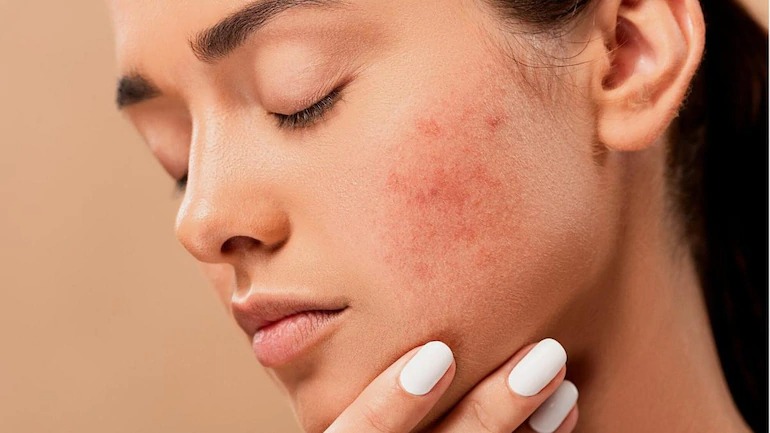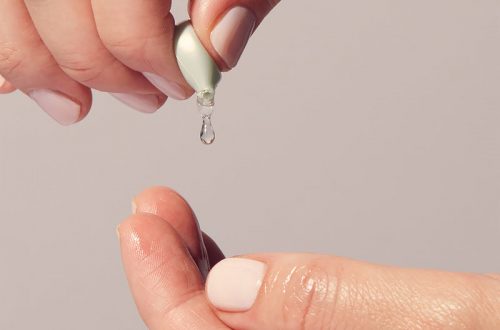
Rosacea: Causes & Symptoms
What is rosacea?
Rosacea has many names: copper rose, copper rose, couperose, rosacea or adult acne. This is a non-contagious but chronic inflammatory skin disease. Those affected have redness, pimples and nodules in the facial area, mainly on the cheeks, nose, forehead and chin. Less commonly, the eyes and eyelids also become inflamed from the disease.
Rosacea occurs in phases and is triggered by various factors. In most cases, the disease first appears between 30 and 50. Since there are different forms, it isn’t easy to estimate how many people worldwide suffer from rosacea. In regions with a fair-skinned population, about 1-10% of people are affected. Women are affected more often than men; in men, the symptoms are more pronounced.
The name rosacea, couperose, or copper rose goes back to the Latin word “rosacea” (rose-colored) and alludes to the similarity of facial redness with the blossoming of a rose. The name “adult acne” is a misleading term for the disease since the characteristic blackheads (comedones) are missing, and therefore there is no connection with the actual acne (acne vulgaris).
Causes of Rosacea
The exact causes of the occurrence of rosacea are not yet fully understood and are the subject of current research. Although there are probably many different influencing factors that lead to the development of the disease, the following three disorders can usually be found in those affected:
- Facial vasodilation and flushing, which can be triggered by stress, alcohol consumption, cigarette smoking, coffee, sunlight, and very cold or warm weather 7
- Inflammation around the hair root
- Too much sebum production
- Another factor currently being researched that aggravates the above issues is a compromised immune system. This can lead to increased production of something called cathelicidin, which dilates blood vessels and has been found in high concentrations in the skin of rosacea sufferers.
In addition, a genetic influence is also possible since those affected often have family members who also suffer from rosacea. So far, however, no specific responsible gene has been identified that could be tested for, for example. For this reason, it is assumed that a combination of many factors triggers the disease.
It can also be observed that light-skinned and red-haired people suffer from rosacea more often. In writings from Anglo-American countries, couperose is also known as the “curse of the Celts”.
Symptoms of Rosacea
Rosacea typically comes in flares and primarily affects the centre of the face. Cheeks, nose, chin and forehead show skin changes, and less often, the neck and décolleté are affected.
Depending on the severity of the symptoms, three different stages of rosacea are distinguished:
Those affected suffer from reddened facial skin that burns, stings or itches. This redness subsides spontaneously but later persists permanently.
Stage 1 (rosacea erythemato-telangiectatica, copper fin, couperose):
Those affected suffer from reddened facial skin that burns, stings or itches. This redness subsides spontaneously but persists over time.
Stage 2 (rosacea papulopustulosa):
In addition to reddening the skin and dilated vessels, there are nodules (papules) and pus-filled blisters (pustules).
Stage 3 (rosacea hypertrophica):
The connective tissue and the sebaceous glands proliferated. Especially in men, this can cause a nodular thickening of the nose (rhinophyma), colloquially known as bulbous, potato or drunkard nose. Rarely, skin growths occur in the area of the ears, chin, bridge of the nose or eyelids.
Special forms of rosacea
In addition, there is the so-called ophthalmo-rosacea. The inflammation also affects the eyes and eyelids, regardless of whether the skin is involved. The eyes are dry and can become inflamed, especially in the area of the conjunctiva, the edge of the eyelid and the iris, and more rarely in the cornea area.
If the cornea is inflamed, those affected should consult an ophthalmologist immediately, as the inflammation can lead to blindness if left untreated. If patients repeatedly suffer from styes, this can also indicate rosacea.
In addition to these stages, there are other unique forms of rosacea, such as lupoid or granulomatous rosacea, in which brownish-red nodules appear which, when pressed with a glass spatula, reveal an apple jelly-like infiltrate, or rosacea conglobata, in which painful nodules form.
Permanent, very severe facial swelling and severe redness can be a so-called Morbihan disease. When rosacea occurs in childhood, the focus is on eye symptoms.
Most of those affected suffer from a mixed form of the disease with symptoms of different stages. Individual complaints also differ from person to person in terms of their severity, which is why there are many options for therapy.




